Grace Elliot's Blog: 'Familiar Felines.' , page 10
July 23, 2014
Thoroughbreds: a Short History of the Turf by Regina Jeffers
I'm delighted to welcome fellow author of historical romance, Regina Jeffers, to Fall in Love wit History. In a short series of guest posts with an animal theme, Regina posts about the history of the thoroughbred. Regina is a well-respected and highly qualified teacher, and a successful author. If you would like to know more about Regina's work here is the link to her website. But without further ado, over to my guestG xOne of the more challenging aspects of writing historical romance is the amount of research one must do. It is not uncommon to spend 8 hours researching a fact that in less than a paragraph in the book. However, one must do it or face the wrath of history savvy readers. Recently, I added the element of thoroughbred racing to a novella entitled “His American Heartsong” (found in His: Two Regency Novellas). I have always said if I hit the lottery, I would move to Kentucky and raise thoroughbreds. So, finding out about thoroughbreds was time consuming, but oh, so exciting.
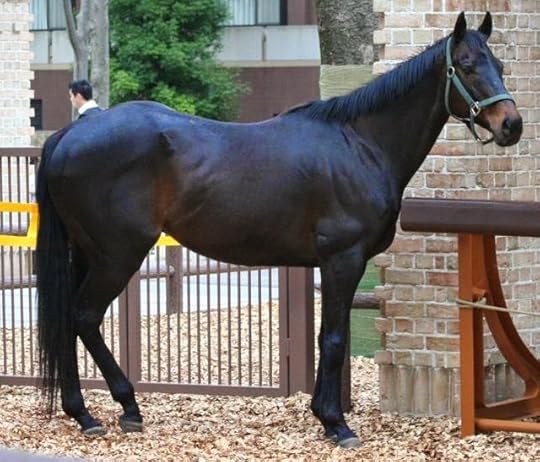 A modern thoroughbred horseFor example, did you know the origins of modern racing go back to the Crusades. Between the 12th and 16th centuries, Arab stallions were imported into England and mated with English mares to breed in speed and endurance.Professional horse racing sprang to life in the reign of Queen Anne (1702-1714). By 1750, racing’s elite formed the Jockey Club at Newmarket. The Jockey Club still exercises complete control of English racing.Since 1814, five races for 3-year-olds have been designated as “Classics”: The English Triple Crown, which includes the Epsom Derby, the 2000 Guineas, and the St. Leger Stakes, is open to both male and female horses. The Epsom Oaks and the 1000 Guineas is only for fillies.
A modern thoroughbred horseFor example, did you know the origins of modern racing go back to the Crusades. Between the 12th and 16th centuries, Arab stallions were imported into England and mated with English mares to breed in speed and endurance.Professional horse racing sprang to life in the reign of Queen Anne (1702-1714). By 1750, racing’s elite formed the Jockey Club at Newmarket. The Jockey Club still exercises complete control of English racing.Since 1814, five races for 3-year-olds have been designated as “Classics”: The English Triple Crown, which includes the Epsom Derby, the 2000 Guineas, and the St. Leger Stakes, is open to both male and female horses. The Epsom Oaks and the 1000 Guineas is only for fillies.
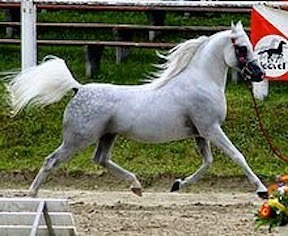 A modern Arab horseIn addition to writing rules for racing, the Jockey Club defined steps to regulate horse breeding. James Weatherby traced the complete family history (pedigree) of every horse to race in England. Weatherby served the Jockey Club as its Secretary in 1770. Between 1770 and 1805, he helped to lay the foundation for racehorse pedigrees. With the assistance of his nephews, The General Stud Book, a definitive record of the pedigrees of approximately 400 horses, which were seen as the foundation for all thoroughbred stock worldwide, was published in 1791. By the early 1800s only horses descended from those listed in the General Stud Book could be called “thoroughbreds.”
A modern Arab horseIn addition to writing rules for racing, the Jockey Club defined steps to regulate horse breeding. James Weatherby traced the complete family history (pedigree) of every horse to race in England. Weatherby served the Jockey Club as its Secretary in 1770. Between 1770 and 1805, he helped to lay the foundation for racehorse pedigrees. With the assistance of his nephews, The General Stud Book, a definitive record of the pedigrees of approximately 400 horses, which were seen as the foundation for all thoroughbred stock worldwide, was published in 1791. By the early 1800s only horses descended from those listed in the General Stud Book could be called “thoroughbreds.”
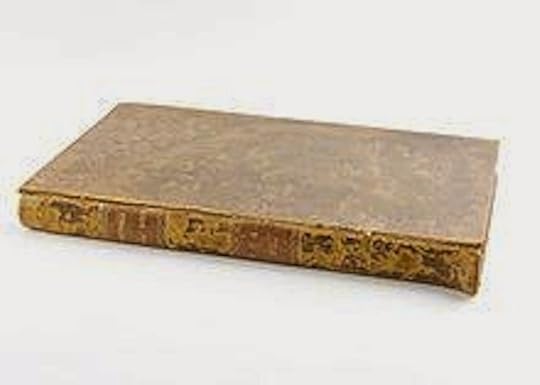 The General Stud Book
The General Stud Book
Published London, 1857Now this is the amazing fact!!! Breed histories generally focus on one of three stallions, which are referred to as the “foundation sires.” These stallions are Byerley Turk (foaled c.1679); the Darley Arabian (foaled c.1700), and Godolphin Arabian (foaled c. 1724).The three founding fathers of the turfFollowing the family tree of the Godolphin Arabian, the Byerley Turk and the Darley Arabian is rather like compiling a ‘who’s who’ of racing champions!The Godolphin Arabian**Foaled about 1724 **Probably exported from Yemen via Syria to the stud of the Bey of Tunis **Initially given to Louis XV of France in 1730, he was then imported to Britain **Sired the best racehorse of the day, called Lath **The Godolphin Arabian’s line hasn’t won the Derby since Santa Claus in 1964, and has recently been overshadowed by the Darley Arabian’s descendantsThe Byerley Turk**Foaled about 1680 **His line includesDescendent Highflyer and his sons were champion stallions 23 times in 25 years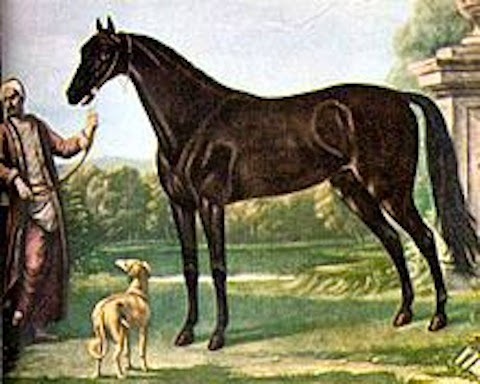 The Byerley Turk
The Byerley Turk
One of the progenitors of the modern thoroughbred**The Byerley Turk’s line now has much less influence than that of the Darley Arabian. The Darley Arabian**Foaled about 1700**Amongst others, he sired Bartlett’s Childers whose great grandson was Eclipse**Over 80% of modern racehorses can trace their descent to Eclipse, including the great Canadian stallion Northern Dancer.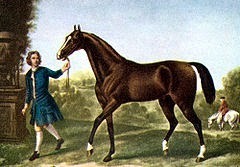 The Darley arabianThe golden story of EclipseA descendent of the Darley Arabian, Eclipse was foaled in 1764, the year of the great eclipse of the sun. He won 18 races, never appearing the least bit stretched. Owners were reluctant to put their horses up against him and eight of his races were declared walkovers!Eclipse retired to stud in 1771 and sired three Derby winners but his ability to sire offspring that were well adapted to the new shorter races for two and three year olds ensured him a place in the racing history books.However, due to terrific competition from Herod and the Byerley Turk line, Eclipse was never actually declared champion.After his death, Eclipse was dissected to try to work out the secret of his success – it was decided that his huge heart pumped blood around the body more effectively, while his back legs gave plenty of leverage. Powerful lungs completed the winning combination. His skeleton is still owned by the Royal Veterinary College. [Note by Grace: I have seen the sombre sight of Eclispe's skeletion. It is on display in the foyee of the main building at the RVC's site at Potters Bar. Even so, the skeleton has an elegance and vivacity that you would not credit bones with.]
The Darley arabianThe golden story of EclipseA descendent of the Darley Arabian, Eclipse was foaled in 1764, the year of the great eclipse of the sun. He won 18 races, never appearing the least bit stretched. Owners were reluctant to put their horses up against him and eight of his races were declared walkovers!Eclipse retired to stud in 1771 and sired three Derby winners but his ability to sire offspring that were well adapted to the new shorter races for two and three year olds ensured him a place in the racing history books.However, due to terrific competition from Herod and the Byerley Turk line, Eclipse was never actually declared champion.After his death, Eclipse was dissected to try to work out the secret of his success – it was decided that his huge heart pumped blood around the body more effectively, while his back legs gave plenty of leverage. Powerful lungs completed the winning combination. His skeleton is still owned by the Royal Veterinary College. [Note by Grace: I have seen the sombre sight of Eclispe's skeletion. It is on display in the foyee of the main building at the RVC's site at Potters Bar. Even so, the skeleton has an elegance and vivacity that you would not credit bones with.]
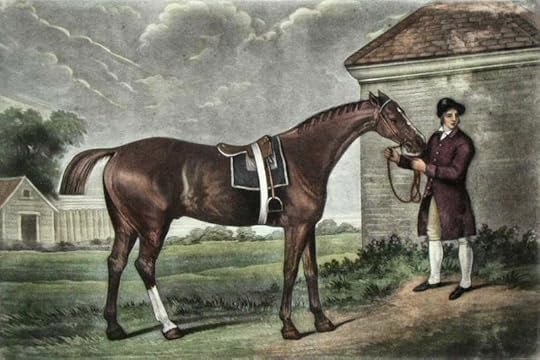 EclipseThe Thoroughbred Heritage website (which includes detailed lists of the sire lines for the three foundation sires) says of the “Historic Sires”: “Thoroughbreds descend in tail-male line to one of these stallions, upwards of 200 stallions, Arabians, Barbs, Turks, and others, were imported into England and are so noted in the General Stud Book. History has managed to overlook many of these early sires, despite the fact that some wielded an even more profound influence on the breed than any one of the three foundation sires. Some, such as the Darcy White Turk had male lines that survived five and six generations and produced many important runners and sires before becoming extinct in direct male descent. Others, such as Fairfax’s Morocco Barb, survive in pedigrees through a single son or daughter, but their blood still runs deep in the Thoroughbred.”
EclipseThe Thoroughbred Heritage website (which includes detailed lists of the sire lines for the three foundation sires) says of the “Historic Sires”: “Thoroughbreds descend in tail-male line to one of these stallions, upwards of 200 stallions, Arabians, Barbs, Turks, and others, were imported into England and are so noted in the General Stud Book. History has managed to overlook many of these early sires, despite the fact that some wielded an even more profound influence on the breed than any one of the three foundation sires. Some, such as the Darcy White Turk had male lines that survived five and six generations and produced many important runners and sires before becoming extinct in direct male descent. Others, such as Fairfax’s Morocco Barb, survive in pedigrees through a single son or daughter, but their blood still runs deep in the Thoroughbred.”
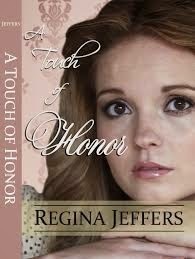
 A modern thoroughbred horseFor example, did you know the origins of modern racing go back to the Crusades. Between the 12th and 16th centuries, Arab stallions were imported into England and mated with English mares to breed in speed and endurance.Professional horse racing sprang to life in the reign of Queen Anne (1702-1714). By 1750, racing’s elite formed the Jockey Club at Newmarket. The Jockey Club still exercises complete control of English racing.Since 1814, five races for 3-year-olds have been designated as “Classics”: The English Triple Crown, which includes the Epsom Derby, the 2000 Guineas, and the St. Leger Stakes, is open to both male and female horses. The Epsom Oaks and the 1000 Guineas is only for fillies.
A modern thoroughbred horseFor example, did you know the origins of modern racing go back to the Crusades. Between the 12th and 16th centuries, Arab stallions were imported into England and mated with English mares to breed in speed and endurance.Professional horse racing sprang to life in the reign of Queen Anne (1702-1714). By 1750, racing’s elite formed the Jockey Club at Newmarket. The Jockey Club still exercises complete control of English racing.Since 1814, five races for 3-year-olds have been designated as “Classics”: The English Triple Crown, which includes the Epsom Derby, the 2000 Guineas, and the St. Leger Stakes, is open to both male and female horses. The Epsom Oaks and the 1000 Guineas is only for fillies.
 A modern Arab horseIn addition to writing rules for racing, the Jockey Club defined steps to regulate horse breeding. James Weatherby traced the complete family history (pedigree) of every horse to race in England. Weatherby served the Jockey Club as its Secretary in 1770. Between 1770 and 1805, he helped to lay the foundation for racehorse pedigrees. With the assistance of his nephews, The General Stud Book, a definitive record of the pedigrees of approximately 400 horses, which were seen as the foundation for all thoroughbred stock worldwide, was published in 1791. By the early 1800s only horses descended from those listed in the General Stud Book could be called “thoroughbreds.”
A modern Arab horseIn addition to writing rules for racing, the Jockey Club defined steps to regulate horse breeding. James Weatherby traced the complete family history (pedigree) of every horse to race in England. Weatherby served the Jockey Club as its Secretary in 1770. Between 1770 and 1805, he helped to lay the foundation for racehorse pedigrees. With the assistance of his nephews, The General Stud Book, a definitive record of the pedigrees of approximately 400 horses, which were seen as the foundation for all thoroughbred stock worldwide, was published in 1791. By the early 1800s only horses descended from those listed in the General Stud Book could be called “thoroughbreds.”
 The General Stud Book
The General Stud BookPublished London, 1857Now this is the amazing fact!!! Breed histories generally focus on one of three stallions, which are referred to as the “foundation sires.” These stallions are Byerley Turk (foaled c.1679); the Darley Arabian (foaled c.1700), and Godolphin Arabian (foaled c. 1724).The three founding fathers of the turfFollowing the family tree of the Godolphin Arabian, the Byerley Turk and the Darley Arabian is rather like compiling a ‘who’s who’ of racing champions!The Godolphin Arabian**Foaled about 1724 **Probably exported from Yemen via Syria to the stud of the Bey of Tunis **Initially given to Louis XV of France in 1730, he was then imported to Britain **Sired the best racehorse of the day, called Lath **The Godolphin Arabian’s line hasn’t won the Derby since Santa Claus in 1964, and has recently been overshadowed by the Darley Arabian’s descendantsThe Byerley Turk**Foaled about 1680 **His line includesDescendent Highflyer and his sons were champion stallions 23 times in 25 years
 The Byerley Turk
The Byerley TurkOne of the progenitors of the modern thoroughbred**The Byerley Turk’s line now has much less influence than that of the Darley Arabian. The Darley Arabian**Foaled about 1700**Amongst others, he sired Bartlett’s Childers whose great grandson was Eclipse**Over 80% of modern racehorses can trace their descent to Eclipse, including the great Canadian stallion Northern Dancer.
 The Darley arabianThe golden story of EclipseA descendent of the Darley Arabian, Eclipse was foaled in 1764, the year of the great eclipse of the sun. He won 18 races, never appearing the least bit stretched. Owners were reluctant to put their horses up against him and eight of his races were declared walkovers!Eclipse retired to stud in 1771 and sired three Derby winners but his ability to sire offspring that were well adapted to the new shorter races for two and three year olds ensured him a place in the racing history books.However, due to terrific competition from Herod and the Byerley Turk line, Eclipse was never actually declared champion.After his death, Eclipse was dissected to try to work out the secret of his success – it was decided that his huge heart pumped blood around the body more effectively, while his back legs gave plenty of leverage. Powerful lungs completed the winning combination. His skeleton is still owned by the Royal Veterinary College. [Note by Grace: I have seen the sombre sight of Eclispe's skeletion. It is on display in the foyee of the main building at the RVC's site at Potters Bar. Even so, the skeleton has an elegance and vivacity that you would not credit bones with.]
The Darley arabianThe golden story of EclipseA descendent of the Darley Arabian, Eclipse was foaled in 1764, the year of the great eclipse of the sun. He won 18 races, never appearing the least bit stretched. Owners were reluctant to put their horses up against him and eight of his races were declared walkovers!Eclipse retired to stud in 1771 and sired three Derby winners but his ability to sire offspring that were well adapted to the new shorter races for two and three year olds ensured him a place in the racing history books.However, due to terrific competition from Herod and the Byerley Turk line, Eclipse was never actually declared champion.After his death, Eclipse was dissected to try to work out the secret of his success – it was decided that his huge heart pumped blood around the body more effectively, while his back legs gave plenty of leverage. Powerful lungs completed the winning combination. His skeleton is still owned by the Royal Veterinary College. [Note by Grace: I have seen the sombre sight of Eclispe's skeletion. It is on display in the foyee of the main building at the RVC's site at Potters Bar. Even so, the skeleton has an elegance and vivacity that you would not credit bones with.]
 EclipseThe Thoroughbred Heritage website (which includes detailed lists of the sire lines for the three foundation sires) says of the “Historic Sires”: “Thoroughbreds descend in tail-male line to one of these stallions, upwards of 200 stallions, Arabians, Barbs, Turks, and others, were imported into England and are so noted in the General Stud Book. History has managed to overlook many of these early sires, despite the fact that some wielded an even more profound influence on the breed than any one of the three foundation sires. Some, such as the Darcy White Turk had male lines that survived five and six generations and produced many important runners and sires before becoming extinct in direct male descent. Others, such as Fairfax’s Morocco Barb, survive in pedigrees through a single son or daughter, but their blood still runs deep in the Thoroughbred.”
EclipseThe Thoroughbred Heritage website (which includes detailed lists of the sire lines for the three foundation sires) says of the “Historic Sires”: “Thoroughbreds descend in tail-male line to one of these stallions, upwards of 200 stallions, Arabians, Barbs, Turks, and others, were imported into England and are so noted in the General Stud Book. History has managed to overlook many of these early sires, despite the fact that some wielded an even more profound influence on the breed than any one of the three foundation sires. Some, such as the Darcy White Turk had male lines that survived five and six generations and produced many important runners and sires before becoming extinct in direct male descent. Others, such as Fairfax’s Morocco Barb, survive in pedigrees through a single son or daughter, but their blood still runs deep in the Thoroughbred.”

Published on July 23, 2014 01:59
July 16, 2014
Henry VIII's Bedtime Habits
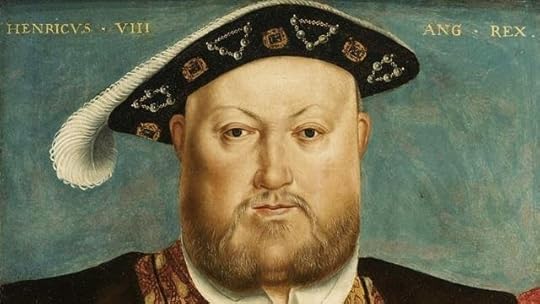
The Tudor court was rife with politics and power-play – and never more so than in the bedroom. Being a gentleman of the King’s bedchamber meant intimate contact with the monarch – and so only the most privileged and trusted were admitted to the position. This was a reflection of the closeness to the monarch’s ear and possible influence on government policy.
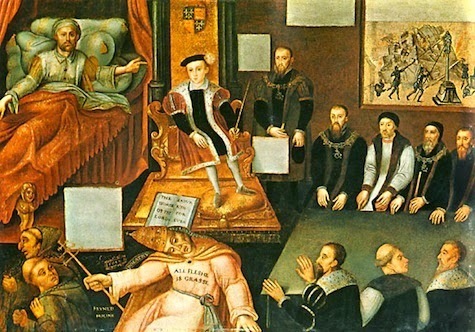 Henry VIII holding court in his bedchamberKeys to the bedchamber became a symbol of power. That most intimate of servants, The Groom of the Stool (the stool referred to is the Tudor equivalent of the toilet) wore as a badge of office ‘a gold key on a blue ribbon’ – and had to authority to demand that ‘no other keys for the bed-chamber be made or allowed.’ Even so the king had little privacy.See his sheets be clean, then fold down his bed, and warm his night kerchief and see his house of office be clean, help off his clothes, and draw the curtains, make sure the fire and candles, avoid [throw out] the dogs, and shut the doors.
Henry VIII holding court in his bedchamberKeys to the bedchamber became a symbol of power. That most intimate of servants, The Groom of the Stool (the stool referred to is the Tudor equivalent of the toilet) wore as a badge of office ‘a gold key on a blue ribbon’ – and had to authority to demand that ‘no other keys for the bed-chamber be made or allowed.’ Even so the king had little privacy.See his sheets be clean, then fold down his bed, and warm his night kerchief and see his house of office be clean, help off his clothes, and draw the curtains, make sure the fire and candles, avoid [throw out] the dogs, and shut the doors.

Henry VIII didn’t sleep with his wife unless he wanted intercourse in which event he visited her chambers. However, there were always attendants in his room, either sleeping on a small wheeled bed pulled out from beneath the royal bed, or even favoured servants such as Thomas Culpepper ‘ordinarily shared [the King’s] bed’.Henry VIII had a set of household rules about how to make up his bed. He slept on a pile of eight mattresses and each night he had a servant roll on the bed, to check for hidden enemies with daggers. After this the servant would kiss the places he had touched, sprinkle the sheets with holy water and make the sign of the cross over the bed.

But over time, even Henry became tired of this invasion of privacy. At Hampton Court he built so-called ‘secret lodgings’ with a new policy for bedchamber staff. Of his six Gentlemen of the Bedchamber, only one now had the automatic right to enter – the rest had to be invited. “The King’s express commandment is, that none other of the said six gentlemen, presume to enter of follow his Grace into the said bed chamber, or any other secret place, unless he shall be called.” Henry I employed a ‘porter of the King’s bed’ – a man with a packhorse whose job it was to convey the king’s bed from castle to castle. A royal progress was a means by which the monarch exerted his authority over his nobles. Any aristocrat seeking to impress maintained a special bedroom for visiting sovereigns. This meant having a state-bed; a colossal construction with a canopy fifteen foot high, hung with gorgeous and expensive tapestries. One example was the state bed at Woburn Abbey, commissioned appropriately enough by the Duke of Bedford – at a cost equivalent to today of half a million pounds.

Sumptuous as a state bed sounds, sometimes there is no substitute for comfort rather than show. Elizabeth I spent her last nights of life on a pile of cushions on the floor, rather than in her 11 foot ostrich-feather bed – proving size isn’t everything.
Published on July 16, 2014 03:03
July 12, 2014
Welcome! "Queen of Bedlam" Author Laura Purcell
Today I'm delighted to welcome author, Laura Purcell to Fall in Love with History. As an indie author Laura's has achieved what most can only dream of, being spotted and signed by major publisher Myrmidon. Laura is a fellow member of the English Historical Fiction Authors group, and is always so supportive that it is with great pleasure. Over to Laura...
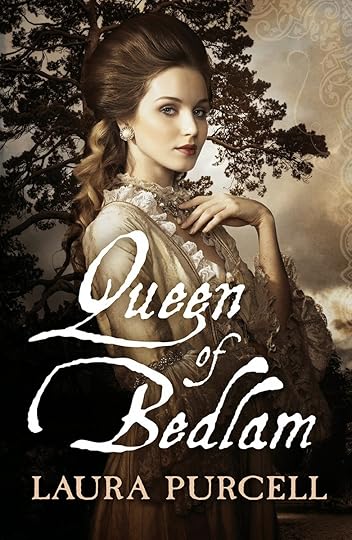
When you write biographical fiction, you need to have a connection with your subject. One of the aspects of Queen Charlotte’s character that endeared to me was her fondness for dogs. Even though this queen had fifteen children, her heart was never too full for a canine companion. Laura Purcell Charlotte rarely appears in a portrait without her dogs. Even her statue in the town of Charlotte North Carolina has a dog jumping up her skirts. Although Charlotte’s pets would not be like the breeds we recognise today, the visual records show similarities to modern dogs. An early portrait of Charlotte with her two young sons, George and Frederick, has her resting her hand on the head of what looks to be a Great Dane. In the 1779 picture by Benjamin West, she has a long haired white dog, similar to a Papillion, at her feet. Later, in Gainsborough’s portrait of 1781, we see a white and tan spaniel like a Cavalier King Charles. Over a decade on, Charlotte appears in a painting by Sir William Beechey with no less than three dogs; one in her arms that looks like a Shi Tzu, with a possible Border Collie and Greyhound lounging behind. That’s a lot of canines, all beloved enough to make it into an official portrait!The first dog I came across in Charlotte’s life was at the start of her marriage in 1761. An inventory of St. James’s Palace lists “a large soft cushion stuffed with hair” for the queen’s dog Presto. Presto was evidently a great favourite - there are records of him following Charlotte on official occasions and tripping her guests up! However, he was later eclipsed by a spaniel named Badine.
Laura Purcell Charlotte rarely appears in a portrait without her dogs. Even her statue in the town of Charlotte North Carolina has a dog jumping up her skirts. Although Charlotte’s pets would not be like the breeds we recognise today, the visual records show similarities to modern dogs. An early portrait of Charlotte with her two young sons, George and Frederick, has her resting her hand on the head of what looks to be a Great Dane. In the 1779 picture by Benjamin West, she has a long haired white dog, similar to a Papillion, at her feet. Later, in Gainsborough’s portrait of 1781, we see a white and tan spaniel like a Cavalier King Charles. Over a decade on, Charlotte appears in a painting by Sir William Beechey with no less than three dogs; one in her arms that looks like a Shi Tzu, with a possible Border Collie and Greyhound lounging behind. That’s a lot of canines, all beloved enough to make it into an official portrait!The first dog I came across in Charlotte’s life was at the start of her marriage in 1761. An inventory of St. James’s Palace lists “a large soft cushion stuffed with hair” for the queen’s dog Presto. Presto was evidently a great favourite - there are records of him following Charlotte on official occasions and tripping her guests up! However, he was later eclipsed by a spaniel named Badine.
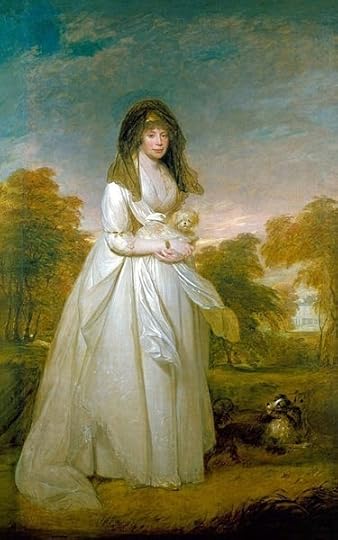 Queen Charlotte with one of her dogsBadine, which means “playful” in French, was the most famous of Charlotte’s dogs. He was at court around the same time as Fanny Burney, which means he featured in many of the novelist’s diaries and letters.The queen, Burney wrote, when she goes to early prayers, often leaves me the charge of her little favourite dog, Badine. To-day, after her return, she sent her page for him; and presently after, I had a rap again at the door, and the little Princess Sophia entered. "Miss Burney," cried she, curtseying and colouring, "Mamma has sent me for the little dog's basket." It seems Badine was a dog particularly attune to his owner’s feelings. Charlotte was deeply distressed after an assassination attempt on her husband. Badine would not leave her while she was unhappy. When [the queen} was dressed for the chapel, she desired me to keep little Badine; but he ran out after her.
Queen Charlotte with one of her dogsBadine, which means “playful” in French, was the most famous of Charlotte’s dogs. He was at court around the same time as Fanny Burney, which means he featured in many of the novelist’s diaries and letters.The queen, Burney wrote, when she goes to early prayers, often leaves me the charge of her little favourite dog, Badine. To-day, after her return, she sent her page for him; and presently after, I had a rap again at the door, and the little Princess Sophia entered. "Miss Burney," cried she, curtseying and colouring, "Mamma has sent me for the little dog's basket." It seems Badine was a dog particularly attune to his owner’s feelings. Charlotte was deeply distressed after an assassination attempt on her husband. Badine would not leave her while she was unhappy. When [the queen} was dressed for the chapel, she desired me to keep little Badine; but he ran out after her.
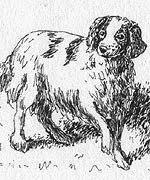 Badine
Badine
Badine was also one of the first dogs admitted to the presence of George III during his bout of “madness” in 1788. The King tied a blue ribbon around Badine’s neck, declaring that the dog loved him, not Charlotte. Poor Badine must have been very confused by the shifting mood of his master during this time.When George recovered in 1789, the royal family set off on a celebratory tour to Weymouth. They broke their journey at the New Forest, where they were presented with two white Greyhounds wearing silver collars. These probably went into the King’s household, but we do have a record of a smaller, Italian Greyhound in Charlotte’s possession, named Phillis. Phillis was a sweet-natured, elegant pet, “a small masterpiece of nature”. She attended Charlotte and Badine to Weymouth.Another breed Charlotte was fond of was the Pomeranian. There is a painting of Charlotte by Stroehling from 1807 with a Pomeranian jumping up at the side; this may have been one of her pair named Mercury and Phoebe. These small, fluffy dogs obviously made an impression on Charlotte’s son, Prince George. In 1791, the prince commissioned Stubbs to paint his own set of Pomeranians, Fino and Tiny.
Of course dogs were not the only animals Charlotte loved. Her menagerie at Kew boasted elephants, zebra and no less than eighteen kangaroos. With so many children and a veritable zoo of pets, I imagine the servants of George III and Queen Charlotte were kept very busy – and very stressed!
If you would like to know more about Laura and her work, here are some useful links.
http://laurapurcell.com/https://www.facebook.com/pages/Laura-Purcell/376994972313063https://twitter.com/Laura_D_Purcell http://www.amazon.co.uk/Queen-Bedlam-Laura-Purcell/dp/1910183016

When you write biographical fiction, you need to have a connection with your subject. One of the aspects of Queen Charlotte’s character that endeared to me was her fondness for dogs. Even though this queen had fifteen children, her heart was never too full for a canine companion.
 Laura Purcell Charlotte rarely appears in a portrait without her dogs. Even her statue in the town of Charlotte North Carolina has a dog jumping up her skirts. Although Charlotte’s pets would not be like the breeds we recognise today, the visual records show similarities to modern dogs. An early portrait of Charlotte with her two young sons, George and Frederick, has her resting her hand on the head of what looks to be a Great Dane. In the 1779 picture by Benjamin West, she has a long haired white dog, similar to a Papillion, at her feet. Later, in Gainsborough’s portrait of 1781, we see a white and tan spaniel like a Cavalier King Charles. Over a decade on, Charlotte appears in a painting by Sir William Beechey with no less than three dogs; one in her arms that looks like a Shi Tzu, with a possible Border Collie and Greyhound lounging behind. That’s a lot of canines, all beloved enough to make it into an official portrait!The first dog I came across in Charlotte’s life was at the start of her marriage in 1761. An inventory of St. James’s Palace lists “a large soft cushion stuffed with hair” for the queen’s dog Presto. Presto was evidently a great favourite - there are records of him following Charlotte on official occasions and tripping her guests up! However, he was later eclipsed by a spaniel named Badine.
Laura Purcell Charlotte rarely appears in a portrait without her dogs. Even her statue in the town of Charlotte North Carolina has a dog jumping up her skirts. Although Charlotte’s pets would not be like the breeds we recognise today, the visual records show similarities to modern dogs. An early portrait of Charlotte with her two young sons, George and Frederick, has her resting her hand on the head of what looks to be a Great Dane. In the 1779 picture by Benjamin West, she has a long haired white dog, similar to a Papillion, at her feet. Later, in Gainsborough’s portrait of 1781, we see a white and tan spaniel like a Cavalier King Charles. Over a decade on, Charlotte appears in a painting by Sir William Beechey with no less than three dogs; one in her arms that looks like a Shi Tzu, with a possible Border Collie and Greyhound lounging behind. That’s a lot of canines, all beloved enough to make it into an official portrait!The first dog I came across in Charlotte’s life was at the start of her marriage in 1761. An inventory of St. James’s Palace lists “a large soft cushion stuffed with hair” for the queen’s dog Presto. Presto was evidently a great favourite - there are records of him following Charlotte on official occasions and tripping her guests up! However, he was later eclipsed by a spaniel named Badine.
 Queen Charlotte with one of her dogsBadine, which means “playful” in French, was the most famous of Charlotte’s dogs. He was at court around the same time as Fanny Burney, which means he featured in many of the novelist’s diaries and letters.The queen, Burney wrote, when she goes to early prayers, often leaves me the charge of her little favourite dog, Badine. To-day, after her return, she sent her page for him; and presently after, I had a rap again at the door, and the little Princess Sophia entered. "Miss Burney," cried she, curtseying and colouring, "Mamma has sent me for the little dog's basket." It seems Badine was a dog particularly attune to his owner’s feelings. Charlotte was deeply distressed after an assassination attempt on her husband. Badine would not leave her while she was unhappy. When [the queen} was dressed for the chapel, she desired me to keep little Badine; but he ran out after her.
Queen Charlotte with one of her dogsBadine, which means “playful” in French, was the most famous of Charlotte’s dogs. He was at court around the same time as Fanny Burney, which means he featured in many of the novelist’s diaries and letters.The queen, Burney wrote, when she goes to early prayers, often leaves me the charge of her little favourite dog, Badine. To-day, after her return, she sent her page for him; and presently after, I had a rap again at the door, and the little Princess Sophia entered. "Miss Burney," cried she, curtseying and colouring, "Mamma has sent me for the little dog's basket." It seems Badine was a dog particularly attune to his owner’s feelings. Charlotte was deeply distressed after an assassination attempt on her husband. Badine would not leave her while she was unhappy. When [the queen} was dressed for the chapel, she desired me to keep little Badine; but he ran out after her.
 Badine
Badine
Badine was also one of the first dogs admitted to the presence of George III during his bout of “madness” in 1788. The King tied a blue ribbon around Badine’s neck, declaring that the dog loved him, not Charlotte. Poor Badine must have been very confused by the shifting mood of his master during this time.When George recovered in 1789, the royal family set off on a celebratory tour to Weymouth. They broke their journey at the New Forest, where they were presented with two white Greyhounds wearing silver collars. These probably went into the King’s household, but we do have a record of a smaller, Italian Greyhound in Charlotte’s possession, named Phillis. Phillis was a sweet-natured, elegant pet, “a small masterpiece of nature”. She attended Charlotte and Badine to Weymouth.Another breed Charlotte was fond of was the Pomeranian. There is a painting of Charlotte by Stroehling from 1807 with a Pomeranian jumping up at the side; this may have been one of her pair named Mercury and Phoebe. These small, fluffy dogs obviously made an impression on Charlotte’s son, Prince George. In 1791, the prince commissioned Stubbs to paint his own set of Pomeranians, Fino and Tiny.
Of course dogs were not the only animals Charlotte loved. Her menagerie at Kew boasted elephants, zebra and no less than eighteen kangaroos. With so many children and a veritable zoo of pets, I imagine the servants of George III and Queen Charlotte were kept very busy – and very stressed!

If you would like to know more about Laura and her work, here are some useful links.
http://laurapurcell.com/https://www.facebook.com/pages/Laura-Purcell/376994972313063https://twitter.com/Laura_D_Purcell http://www.amazon.co.uk/Queen-Bedlam-Laura-Purcell/dp/1910183016
Published on July 12, 2014 01:00
July 9, 2014
A Tax on Dogs

In 1796 a seemingly innocuous piece of tax legislation caused uproar in England. The new law provoked a debate about the very nature of the human spirit and whether owning a dog was a right or a luxury. At the end of the 18th century the English government was desperate for money to finance the on-going war with France. One way of raising the necessary cash was taxation. Tax was raised on everything from soap, to tea, tobacco, windows and lace – and indeed it didn’t stop there. Servants were a taxable asset under the auspices of the Male Servants’ Tax bill 1777- 1852 and the Female Servant’s Tax bill 1795 – 1852- but fortunately (or unfortunately?) wives and children were not taxable assets!. There was a Horse Tax (for owners of carriages and saddle horses), a Farm Horse Tax (for horses and mules used in trade) – but none of these taxes created quite the same stir as the imposition of the Dog Tax in 1796.

The crux of the disquiet lay in the very English relationship between man to dog. It raised a serious debate about whether a dog was a luxury or a natural part of being human. The tax tapped into questions about the emotional bond between the two. By putting a tax on dogs it implied a shift in relationship from one of nurturing and caring, to servility and subordination – and dog owners were enraged. To many this was tantamount to taxing spouses and children , and people weren’t happy. This wasn’t about the financial aspect of the tax, but the moral implication and feelings ran high. Those that supported the bill pointed out that pet dogs were a luxury, and consumed food that could have been better used to feed the poor. Opposers argued back that to need things beyond the essential – such as a dog – was a distinctly human trait. These people considered pets to be their friends, and putting a tax on them turned the language of friendship to that of slavery and service.

Interestingly, the idea behind the dog tax may have originated in France (the very country the English needed to raise funds to fight!) In 1770 a French census suggested a population of four million dogs –an arithmetic extrapolation of the amount of food they consumed was equivalent to feeding a sixth of the population. The French dog tax was proposed to discourage dog ownership, as a means of disease control and to increase food availability.French authorities also insisted dogs belonging to the poor spread disease – especially rabies. This was considered a disease of dirty and hungry dogs, so poor labourers who – “Can scarcely feed themselves” should be discouraged from owning dogs by means of a tax.
The difference between France and England was that in the former the tax remained as a proposition, whereas in the later it was acted upon. Whatever the moral argument the English government won in the end – the Dog Tax was imposed and stayed in place until 1882.

Published on July 09, 2014 00:14
July 2, 2014
As Popular as Wimbledon: 19th Century Attractions
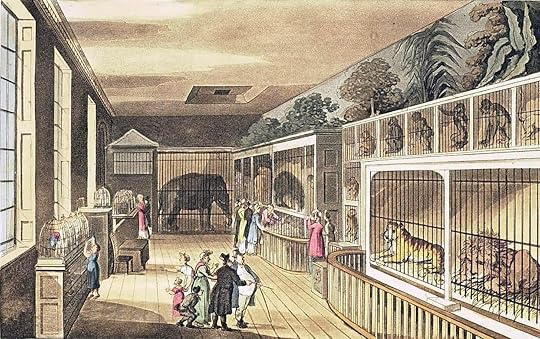 Inside the Exeter Exchange, 1812Between the World Cup and Wimbledon, it seems everyone is talking about, or watching sport this summer. But in previous centuries, it was curiosities that attracted the crowds, sights such as unusual animals or the exotic. Typical of this, in the late 19th century, was George Pidcock and his hugely popular menagerie at the Exeter Exchange.Mr. Pidcock started out as an itinerant showman, hawking animals around fairs and markets. But the poor roads made it difficult to move the animals in winter and Pidcock needed a base. He bought a four-story building, the Exeter Exchange, in the Strand, London – and made his fortune.
Inside the Exeter Exchange, 1812Between the World Cup and Wimbledon, it seems everyone is talking about, or watching sport this summer. But in previous centuries, it was curiosities that attracted the crowds, sights such as unusual animals or the exotic. Typical of this, in the late 19th century, was George Pidcock and his hugely popular menagerie at the Exeter Exchange.Mr. Pidcock started out as an itinerant showman, hawking animals around fairs and markets. But the poor roads made it difficult to move the animals in winter and Pidcock needed a base. He bought a four-story building, the Exeter Exchange, in the Strand, London – and made his fortune.
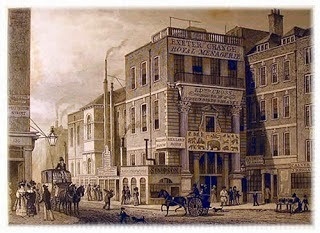 The Exeter Exchange The animals included a rhinoceros, kangaroo, lynx, zebra and rare birds and Pidcock found the public paid handsomely to view his animals, and what started as a temporary solution turned into a permanent display. Such was the success of the venture that he went on to add tigers and an elephant!The visitor paid a shilling to view the three main exhibits, or two shillings to see everything. The menagerie was open for twelve hours a day from 9 am and the most popular time to visit was feeding time at 8 pm. The later was signaled by Chunee, the elephant, ringing a bell. "The Lords of Parliament and the lions of Exeter Change all dined at about eight." William Clarke, journalist.One famous visitor, Lord Byron, remarked that the hippotamus had the face of the Prime Minister, Lord Liverpool – possibly a dubious anecdote since no record exists of a hippo at Pidcock’s menagerie.
The Exeter Exchange The animals included a rhinoceros, kangaroo, lynx, zebra and rare birds and Pidcock found the public paid handsomely to view his animals, and what started as a temporary solution turned into a permanent display. Such was the success of the venture that he went on to add tigers and an elephant!The visitor paid a shilling to view the three main exhibits, or two shillings to see everything. The menagerie was open for twelve hours a day from 9 am and the most popular time to visit was feeding time at 8 pm. The later was signaled by Chunee, the elephant, ringing a bell. "The Lords of Parliament and the lions of Exeter Change all dined at about eight." William Clarke, journalist.One famous visitor, Lord Byron, remarked that the hippotamus had the face of the Prime Minister, Lord Liverpool – possibly a dubious anecdote since no record exists of a hippo at Pidcock’s menagerie.
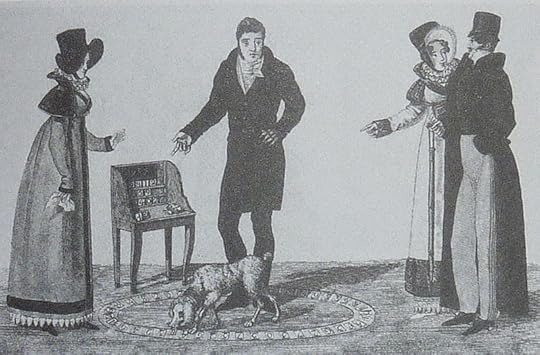 Munito, the learned dogAnother major attraction in the 18th – 19thcentury were performing animals. One such was Munito the ‘learned’ dog. First shown by Signor Castelli in London, 1817, the dog played dominoes, did card tricks and performed arithmetic. Decades later, Charles Dickens recalls, as a boy, seeing Munito. “About 45 years ago, a learned dog was exhibited in Piccadilly - Munito … He performed many curious feats, answering questions, telling the hour of the day … picking out any cards called for from a pack on the ground.” Charles Dickens, 1867Incidentally, Dickens was determined to work out how Munito did his tricks – which perhaps he did.“We watched more narrowly … noticed that between each feat the master gave the dog some small bits … of food, and that there was a faint smell of aniseed from that corner of the room.” Dickens believed that as the owner set out the cards, he pressed his thumb on the chosen card impregnating it with the scent of aniseed which Munito had been trained to recognize. Apparently, he confronted Signor Castelli after the show, with this explanation, who ‘did not deny the discovery.’
Munito, the learned dogAnother major attraction in the 18th – 19thcentury were performing animals. One such was Munito the ‘learned’ dog. First shown by Signor Castelli in London, 1817, the dog played dominoes, did card tricks and performed arithmetic. Decades later, Charles Dickens recalls, as a boy, seeing Munito. “About 45 years ago, a learned dog was exhibited in Piccadilly - Munito … He performed many curious feats, answering questions, telling the hour of the day … picking out any cards called for from a pack on the ground.” Charles Dickens, 1867Incidentally, Dickens was determined to work out how Munito did his tricks – which perhaps he did.“We watched more narrowly … noticed that between each feat the master gave the dog some small bits … of food, and that there was a faint smell of aniseed from that corner of the room.” Dickens believed that as the owner set out the cards, he pressed his thumb on the chosen card impregnating it with the scent of aniseed which Munito had been trained to recognize. Apparently, he confronted Signor Castelli after the show, with this explanation, who ‘did not deny the discovery.’
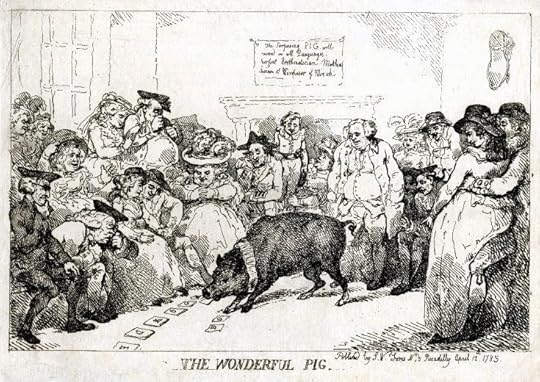
Another late 18thcraze was the performing pig trained by Samuel Bisset. Reputedly he bought the black piglet in Belfast market for 3 shillings, and tutored him for two years before The Learned Pig first made his debut in 1783, Dublin. The pig knelt and bowed, used cardboard letters to spell out names and could point to the married people in the audience. The act succeeded Bisset's wildest dreams and the couple were warmly welcome in novelty seeking London. "…solves questions in the four rules of arithmetic, tells by looking at a …watch, what is the hour and minute and is the admiration of all who have seen him." "…the tongue of the most florid orator…can sufficiently describe the wonderful performance of that sagacious animal."
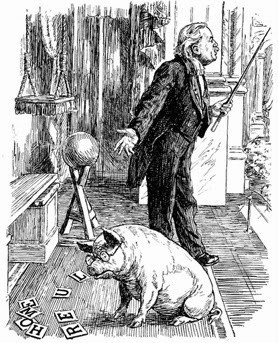
So convincing was the pig's performance that some religious people claimed he was possessed and 'corresponding with the devil'. Others saw it as proof that the soul could migrate suspecting that: 'The spirit of the grunting Philosopher might once have animated a man.'The act amazed the audience as the pig spelt names out with cardboard letters. Crowds flocked to see him and with four shows a day, was rumored to take the huge amount of 70 pounds a week in ticket sales. After a long Londonrun the pig joined a circus performing at Sadler's Wells Theatre. A group of acrobats, incensed at being asked to share a billing with a performing pig, threatened to resign and were sacked on the spot. By 1786, in the world of entertainment the Learned Pig ruled."A far greater object of admiration to the English nation than ever was Sir Isaac Newton." Robert Southey
 Of course, cats are far too clever to perform....
Of course, cats are far too clever to perform....
Published on July 02, 2014 01:11
June 25, 2014
Jonathan Tyers and the Vauxhall Pleasure Gardens
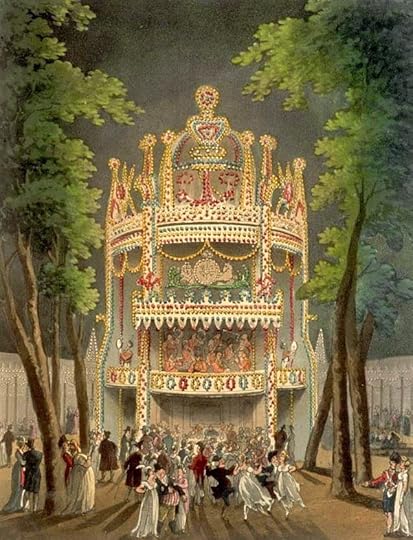 Vauxhall Pleasure GardensIn the mid 18th century, Jonathan Tyers became best known for making the Vauxhall Pleasure Gardens into a spectacular success that lasted another hundred years. Under his ownership the gardens went from a fairly average recreation area on the south bank of the Thames, to the place to visit. From the sensational lighting to orchestral music, from plays to wooded walks, under his stewardship Vauxhall Pleasure Gardens became the haunt of everyone from the Prince of Wales to the common man. His creative innovations were ahead of their time, as was his canny instinct for marketing and publicity. Tyers achievements were many, but what interests us today is the man behind the hype.
Vauxhall Pleasure GardensIn the mid 18th century, Jonathan Tyers became best known for making the Vauxhall Pleasure Gardens into a spectacular success that lasted another hundred years. Under his ownership the gardens went from a fairly average recreation area on the south bank of the Thames, to the place to visit. From the sensational lighting to orchestral music, from plays to wooded walks, under his stewardship Vauxhall Pleasure Gardens became the haunt of everyone from the Prince of Wales to the common man. His creative innovations were ahead of their time, as was his canny instinct for marketing and publicity. Tyers achievements were many, but what interests us today is the man behind the hype.
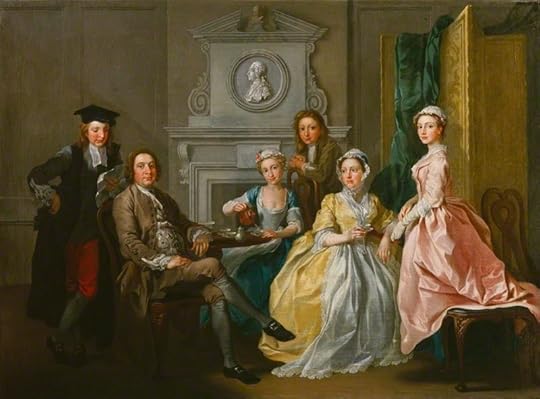 Jonathan Tyers relaxing with his family Tyers was born in 1702, into a family of leatherworkers – dealing in hides and skins. Perhaps he was ashamed of his humble roots because a recurrent theme during his life was raising his social status from tradesman to gentry. Indeed, Tyers was adept at reinventing not only the gardens –but himself.
Jonathan Tyers relaxing with his family Tyers was born in 1702, into a family of leatherworkers – dealing in hides and skins. Perhaps he was ashamed of his humble roots because a recurrent theme during his life was raising his social status from tradesman to gentry. Indeed, Tyers was adept at reinventing not only the gardens –but himself.
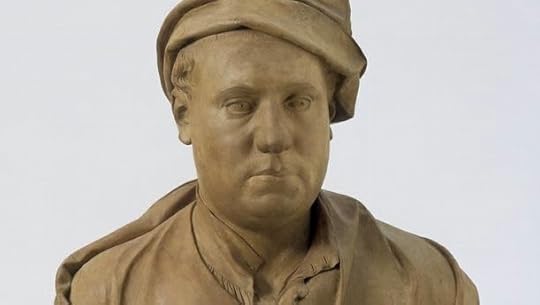 Roubiliac's bust of Tyers At the age of just 27 Tyers acquired the lease for the Spring Gardens at Vauxhall (later renamed the Vauxhall Gardens) for an annual rent of £250. Over the next thirty years he bought out the lease, finally owning the gardens in 1758. A shrew business man with a talent for advertising, Tyers used the talents of eminent artists and musicians of the day. He enlisted William Hogarth to design season tickets, and Handel to compose music for the gardens. Some of his marketing techniques included having a special barge sail up and down the Thames, with musicians on deck playing Handel’s new pieces – to be played at the gardens that night.
Roubiliac's bust of Tyers At the age of just 27 Tyers acquired the lease for the Spring Gardens at Vauxhall (later renamed the Vauxhall Gardens) for an annual rent of £250. Over the next thirty years he bought out the lease, finally owning the gardens in 1758. A shrew business man with a talent for advertising, Tyers used the talents of eminent artists and musicians of the day. He enlisted William Hogarth to design season tickets, and Handel to compose music for the gardens. Some of his marketing techniques included having a special barge sail up and down the Thames, with musicians on deck playing Handel’s new pieces – to be played at the gardens that night.
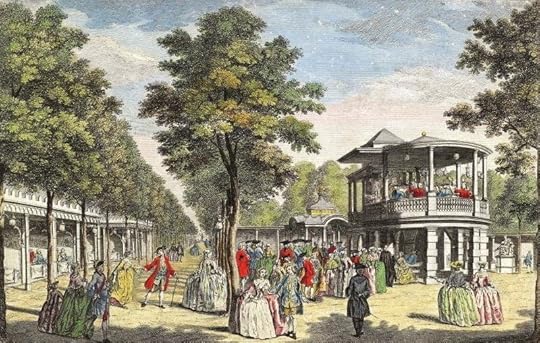 The Grand Walk, Vauxhall, in its heyday Tyers hung hundreds of lanterns (an unthinkably extravagant number in the 18thcentury) from trees lining the walks. Not content with illuminating the gardens, he developed a revolutionary technique of lighting the lanterns, all at the same time – a sight akin to magic in the 1750’s. This rouse was such a success that people flocked to the gardens – just to see the lights being switched on. But what of Tyers himself? He married a woman, Elizabeth, two years older than him and already a widow. Evidently, she was a woman of character and positivity, because, when in old age the house was burgled and a considerable amount of silver stolen – instead of complaining she marveled at the skill of the thieves in breaking in without waking anyone.
The Grand Walk, Vauxhall, in its heyday Tyers hung hundreds of lanterns (an unthinkably extravagant number in the 18thcentury) from trees lining the walks. Not content with illuminating the gardens, he developed a revolutionary technique of lighting the lanterns, all at the same time – a sight akin to magic in the 1750’s. This rouse was such a success that people flocked to the gardens – just to see the lights being switched on. But what of Tyers himself? He married a woman, Elizabeth, two years older than him and already a widow. Evidently, she was a woman of character and positivity, because, when in old age the house was burgled and a considerable amount of silver stolen – instead of complaining she marveled at the skill of the thieves in breaking in without waking anyone.
 I took this photo, in a spot approximating to the view above.
I took this photo, in a spot approximating to the view above.The Grand Walk (?!) in the modern day Tyers was renowned for having a changeable character. For periods of time he was highly motivated and creative, but this alternated with periods of withdrawal and profound melancholia when he became suicidal. It has been postulated he may have suffered from a psychological condition such as bipolar disorder. Under Tyer’s ownership from 1729 to his death in 1767, Vauxhall became the haunt of the fashionable elite – from royalty to dukes, landowners and merchants. For the admission cost of one shilling, the visitor had the exciting prospect of rubbing shoulders with the celebrities of the day.
 The site of Vauxhall Gardens in the modern day.
The site of Vauxhall Gardens in the modern day.Note the Shard in the background Tyers was passionate about Vauxhall right up until his death in 1767. When he was terminally ill, he insisted on being carried through the gardens to say farewell to the place he loved so much. He died at his house in the gardens on 1 July aged 65. He left behind a widow, two daughters and two sons (the younger of which took over the running of the gardens). Jonathan was buried in a churchyard near his family home in Bermondsey. The grave was not marked and the only commemoration to his life now existing is in the street names around the site of the old Vauxhall.
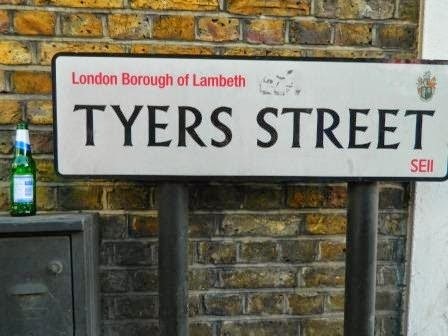
Published on June 25, 2014 03:32
June 18, 2014
The Georgians: Shop to Live, or Live to Shop?

I love history, especially the 18th century and the more I learn about the Georgians, the more it appears they oversaw the birth of many things familiar to us today. Take shopping for example. Before the 1700’s most trade was done direct, straight from producer to customer. If you needed a chicken, you went to a farmer to buy one and if the farmer produced surplus stock, then he took those chickens to market. Likewise craftsmen produced to order and had no need of shop premises because customers approached them directly. People shopped out of necessity, rather than for leisure – perhaps with the except ion travelling pedlars hawking more unusual goods such as tea, tobacco, spices and ribbons.
 1734 - people visited fairs (Southwark Fair featured here) to
1734 - people visited fairs (Southwark Fair featured here) tospend money and enjoy themselves But in the 18th century London expanded at a tremendous rate. Money was poured into building grand terraces, opulent squares and imposing town houses –all of which needed fixtures, fittings and furnishings. A demand for merchandise was born that distanced the consumer from producer. Canny merchants spotted the opportunity to buy good and supply them to towns and cities – the demand for goods as luxuries, rather than necessity had started. These shops were often open from 8am to 11pm and as more shops opened so competition for custom grew and window displays became important to entice the shopper inside. Bow fronted windows gave a larger stage on which to showcase goods.
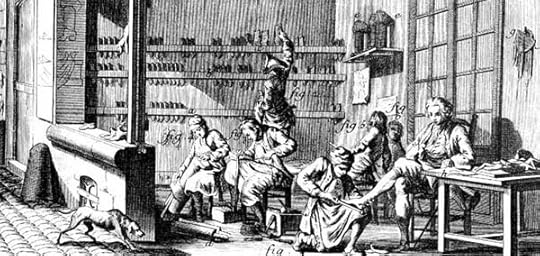 An 18th century shoe shopBut this fledgling consumer society was not without disadvantages for the shopkeeper. The majority of goods did not have a fixed price and could be bargained over (a hark back to haggling in the market) and it was considered ‘odd’ to marks items with a price tag and not haggle. When a purchase was made, it was usual to put goods on account, rather than pay up front. Often a customer ran up an account for a year before settling what he owed – and if he didn’t feel like paying in full, there was little a shopkeeper could do about it. As the century deepened, so shopping became an entertainment in itself, with people idling away the hours at different shops but with no intention of making a purchase:"I have heard, that some Ladies, and those too persons of good note, have taken their coaches and spent a whole afternoon in Ludgate Street, or Covent Garden, only to divert themselves in going from one mercer's shop to another, to look upon their fine silks, and to rattle and banter the shopkeepers, having not so much the least occasion, much less the intention, to buy anything; nay, not so much as carry any money out with them to buy anything if they fancied it." Daniel Defoe – The Complete Tradesman
An 18th century shoe shopBut this fledgling consumer society was not without disadvantages for the shopkeeper. The majority of goods did not have a fixed price and could be bargained over (a hark back to haggling in the market) and it was considered ‘odd’ to marks items with a price tag and not haggle. When a purchase was made, it was usual to put goods on account, rather than pay up front. Often a customer ran up an account for a year before settling what he owed – and if he didn’t feel like paying in full, there was little a shopkeeper could do about it. As the century deepened, so shopping became an entertainment in itself, with people idling away the hours at different shops but with no intention of making a purchase:"I have heard, that some Ladies, and those too persons of good note, have taken their coaches and spent a whole afternoon in Ludgate Street, or Covent Garden, only to divert themselves in going from one mercer's shop to another, to look upon their fine silks, and to rattle and banter the shopkeepers, having not so much the least occasion, much less the intention, to buy anything; nay, not so much as carry any money out with them to buy anything if they fancied it." Daniel Defoe – The Complete Tradesman
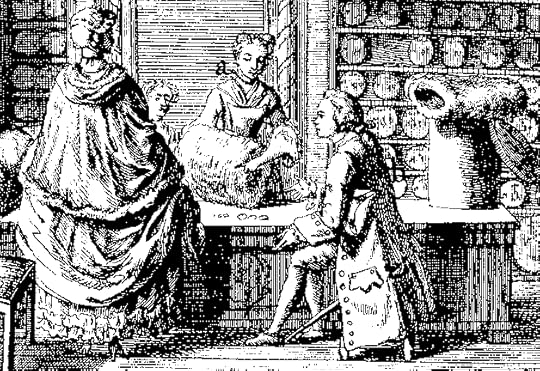 Buying a new muff Indeed, shopkeepers were expected not only to put up with having their time wasted, but to be cheerful about it!“[The shopkeeper] must never be angry, not so much as seen to be so, if a customer tumbles him £100 worth of goods and scarce bid for anything” Daniel Defoe – The Complete Tradesman So you see, in the 18thcentury people stopped shopping to live, and lived to shop! It was also a time when people with spare income spent it on entertainments such as the theatre or visiting a pleasure garden (as featured in The Ringmaster's Daughter).
Buying a new muff Indeed, shopkeepers were expected not only to put up with having their time wasted, but to be cheerful about it!“[The shopkeeper] must never be angry, not so much as seen to be so, if a customer tumbles him £100 worth of goods and scarce bid for anything” Daniel Defoe – The Complete Tradesman So you see, in the 18thcentury people stopped shopping to live, and lived to shop! It was also a time when people with spare income spent it on entertainments such as the theatre or visiting a pleasure garden (as featured in The Ringmaster's Daughter). 
Published on June 18, 2014 00:34
June 11, 2014
How St Albans got its Name
Do you wonder about the history of local towns? I've lived near St. Albans for 18 years, but it was only recently I looked into the origins of this roman settlement. It started life in AD 43 when the Romans built an encampment beside the River Ver and "Verulamium" was born (later renamed St Albans) – and for a while this was the largest Roman town in England. However, at that time most of the buildings were made of wood and destroyed during Queen Boudicca's rebellion of AD 60 -61.
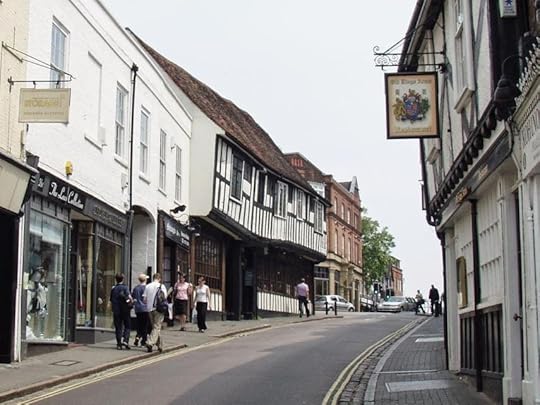 The view along George St, St Albans
The view along George St, St Albans(which also happens to be where one of my all time favourite shops is located)
Undeterred the Romans rebuilt in stone and then a couple of centuries later erected a wall around the town. It was around this time AD 250 -275 (exact date uncertain) that the man who went onto give his name to St Albans - was martyred.
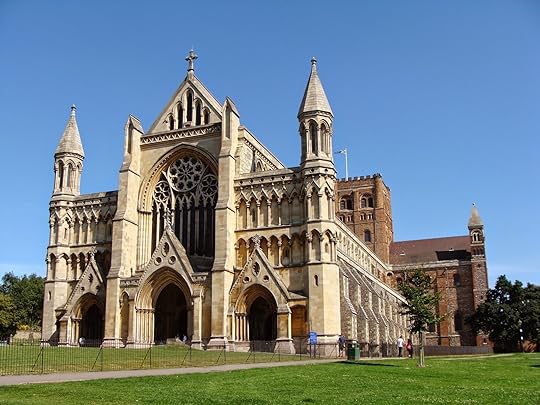 St Alban's cathedral
St Alban's cathedralAlban is acknowledged as the first British Christian martyr and an account of his life is given by the Venerable Bede in his Ecclesiastical History. The story goes that Alban was a pagan who gave a Christian priest, Amphibalus, shelter and hid him from Roman soldiers who were trying to capture him. However, during their time together the priest converted Alban to Christianity and when soldiers arrived to arrest Amphibalus, Alban donned the priest’s garments and took his place. A judge recognized the deception and insisted Alban renounce Christianity – and had him savagely beaten when he refused.
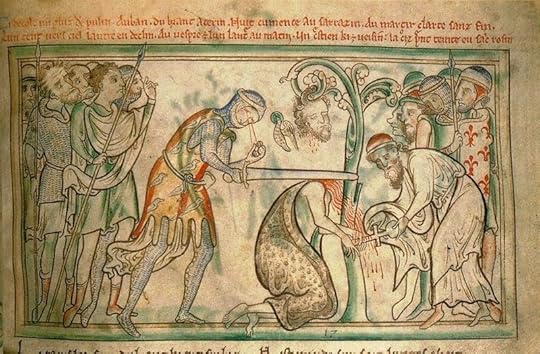 A rather grizzly depiction of Alban's execution
A rather grizzly depiction of Alban's executionAlban was sentenced to death, but on the day of his execution a number of miracles happened which made the executioner refuse to perform his duty. A second executioner was found who beheaded Alban, along with the first executioner - but then this second executioner was struck blind. Alban’s head bounced down a hill (Holywell Hill) and a stream arose where it landed. The place of Alban’s execution is reputedly where St Alban’s cathedral stands today.
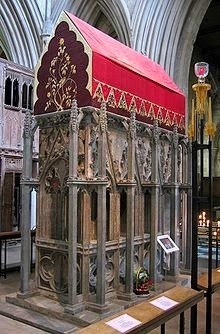 The shrine of St Alban - housed within
The shrine of St Alban - housed withinthe cathedral that bears his name
By AD 410 the roman presence dwindled as the army left, and many of their buildings fell into disrepair. The industrious locals reused bricks and stone, incorporating roman materials into their own houses and barns. Indeed, to this day St Albans is a place with a strong sense of history seeping from its stones, including an "Eleanor Cross" – more of this in another post.
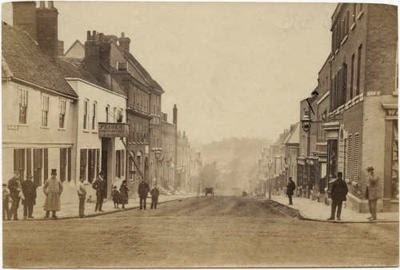 The view down Holywell Hill in the late 19th century
The view down Holywell Hill in the late 19th century
Published on June 11, 2014 00:51
June 4, 2014
The Sinking of the Mary Rose: by guest author, Judith Arnopp
I'm delighted to welcome Judith Arnopp, historical fiction author, to my blog. I've read three of Judith's books (The Winchester Goose, The Concubine's Kiss, and now Intractable Heart) and can heartily recommend them to readers of well-written historical fiction. With impeccable research, Judith's writing immerses you in the Tudor period and excels at making the motivation of the characters believable. Today, Judith shares a post about the sinking of the Tudor warship, the Mary Rose (see excerpt at the end of this post to read the scene in Intractable Heart). Anyhow, enough from me - let me hand over to Judith. Grace x
PS For more Mary Rose info click the link.
 Judith ArnoppOn July 19th 1545, with the loss of more than 400 lives, the royal flagship The Mary Rose sank beneath the waves, settled into the silt of the Solent and became history. Four hundred years later, in 1982, when archaeologists successfully raised her from the seabed, I was watching. I may have been glued to the television screen 70 miles away from Portsmouth but, in my heart, I was there with the team, experiencing one of the most profound moments of my life.
Judith ArnoppOn July 19th 1545, with the loss of more than 400 lives, the royal flagship The Mary Rose sank beneath the waves, settled into the silt of the Solent and became history. Four hundred years later, in 1982, when archaeologists successfully raised her from the seabed, I was watching. I may have been glued to the television screen 70 miles away from Portsmouth but, in my heart, I was there with the team, experiencing one of the most profound moments of my life.
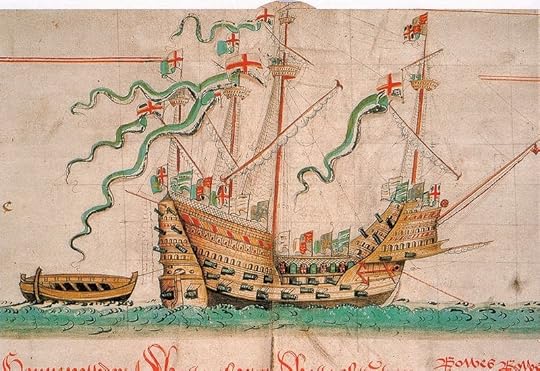
In the intervening years I have visited the museum several times and closely followed the Mary Rose Trust in its unstinting efforts to salvage not just the wreck, but the thousands of artefacts found alongside it. For the past nineteen years the timbers of the wreck have been constantly sprayed with polyethylene glycol to preserve and reinforce the structure, but now the time has come to turn off the spray and begin drying her out. It is also time for the wreck and its artefacts to be brought back together and housed in one fabulous exhibition.
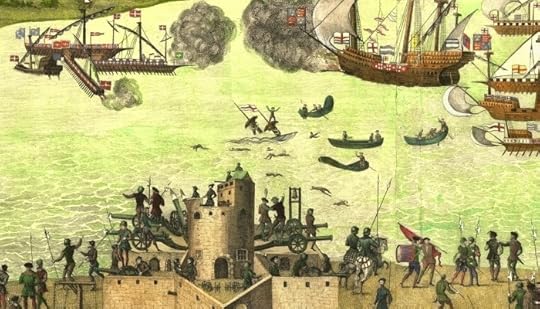
The Mary Rose is the only 16th century warship on display anywhere in the world. She offers an invaluable resource for historians, illustrating in minute detail, life as it was on a Tudor warship. Artefacts that, in normal circumstances, would have been lost to us have been preserved for 500 years in the Solent silt. They can now be viewed in situ in a new museum which opens in Portsmouth in May 2013. Visitors to the museum will be able to walk along a central gangway and view the original wreck on one side while, on the other side, see a reconstruction of how experts believe the interior of the Mary Rose may have looked on the day she sank.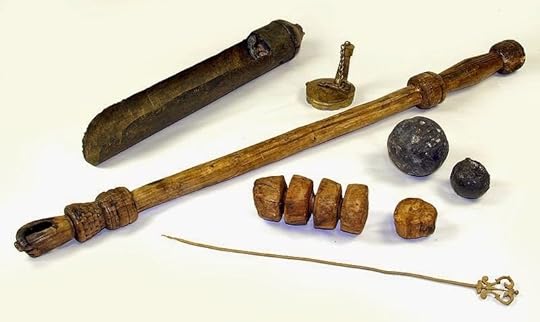 Mary Rose - gun furnitureHenry VIII’s obsession with France left England a legacy of isolation in Europe, religious conflict, inflation, national penury and social upheaval, and what little gains he did make were short lived. In the 1550’s Boulogne was given back to France, and in 1558 Calais, England’s last possession on the continent, was lost. Today we can see that the one positive outcome of his war with France was the Mary Rose. What was undoubtedly a huge loss to Henry VIII that day but she has now become a gift to us as a nation, and every single person who went down with her did not die in vain. They are not forgotten. The wreck of the Mary Rose provides precious insight into life on a Tudor warship, an aspect of 16th century life that would otherwise be completely closed to us.
Mary Rose - gun furnitureHenry VIII’s obsession with France left England a legacy of isolation in Europe, religious conflict, inflation, national penury and social upheaval, and what little gains he did make were short lived. In the 1550’s Boulogne was given back to France, and in 1558 Calais, England’s last possession on the continent, was lost. Today we can see that the one positive outcome of his war with France was the Mary Rose. What was undoubtedly a huge loss to Henry VIII that day but she has now become a gift to us as a nation, and every single person who went down with her did not die in vain. They are not forgotten. The wreck of the Mary Rose provides precious insight into life on a Tudor warship, an aspect of 16th century life that would otherwise be completely closed to us.
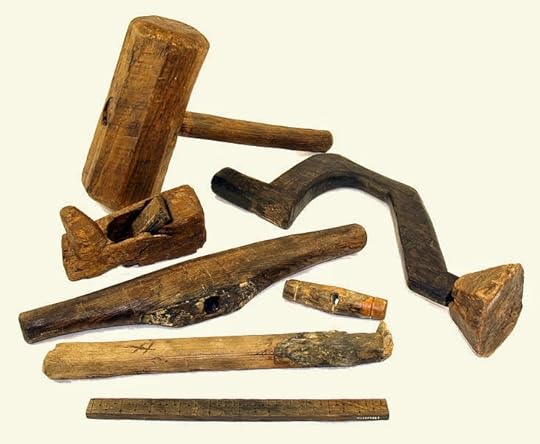 Mary Rose - carpentry toolsIt is not just the salvaged cannon or the armour and weapons that are invaluable, it is the small, everyday things. They have become the greatest treasures. There is no thrill on this earth like looking at a handful of dice last thrown by a sailor in 1545, or a leather shoe last worn by a man defending our shores from French invasion five hundred years ago, or a nit comb still thick with 16th century lice. To me, and other peculiar people like me, those things are rarer, and more thrilling, than the crown jewels.
Mary Rose - carpentry toolsIt is not just the salvaged cannon or the armour and weapons that are invaluable, it is the small, everyday things. They have become the greatest treasures. There is no thrill on this earth like looking at a handful of dice last thrown by a sailor in 1545, or a leather shoe last worn by a man defending our shores from French invasion five hundred years ago, or a nit comb still thick with 16th century lice. To me, and other peculiar people like me, those things are rarer, and more thrilling, than the crown jewels.
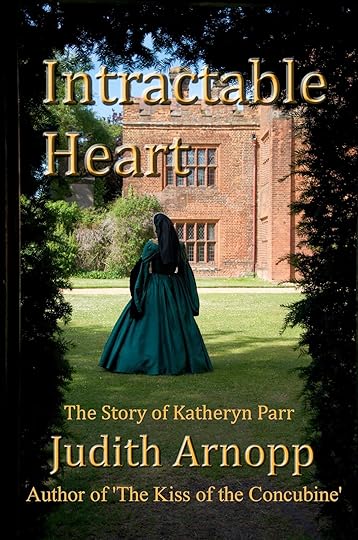
When I came to write my novel Intractable Heart; a story of Katheryn Parr I could not omit the tragedy of the Mary Rose. We do not know for certain if Katheryn was with Henry as he watched his favourite ship sink but it is not beyond the bounds of possibility that she was. Below is an excerpt from the novel depicting the imagined scene.
19th July 1545 – Southsea, Portsmouth
The King points a finger, indicating where the ships should go next. Beside him, ignoring the squeals of the women, Charles Brandon nods. It is as if the men are witnessing a life sized game of chess, as if real lives, real husbands aren’t at risk. I remember Henry explaining that there are more than four hundred and fifty men aboard each ship. I try to imagine the squash, the stench and the squalor. It must be like hell on earth.The king stands proud, hands on hips, his demeanour belying his failing breath, his crippled leg, his lack of virility. He looks out across the sea, his papery cheeks growing pink in the sea air, the white feather in his cap fluttering like a stricken gull. Slowly, the pride of the English navy turns to offer a broadside attack.It is one of those briny coastal days when the wind is sporadic, with intermittent breezes that extinguish the warmth of the sun. A sudden gust, seemingly from nowhere, lifts the King’s cloak, making him shudder. “Someone walking over my grave,” he laughs as he wraps it closer to his bulk. He glances at me and I smile dutifully, convincing him of my adoration. And, engaged as we are in this moment of marital insincerity, we both miss the precise moment when the Mary Rose falters. When we turn back to the panoramic scene, the action is stilled; the flags on the great ship snap and flutter. Like a painting the scene is frozen momentarily, the great ship balanced on the cusp of fate. As if in premonition the king holds his breath, grabs my arm as my heart falters and I send up a prayer. But, in a heartbeat, the ship is heeling over, cries of terror as her open gun ports fill with water. We stand amazed as the first sailors fall from the rigging to splash into the sea. On the snapping breeze the screams of the stricken men are borne toward us and my husband’s prowess instantly shrinks. His breath whistles from his lungs, his grip is tight and painful on my wrist. We watch transfixed as the massive cannon break free, bursting through the sides of the ship, surging into the waves. All around us people are screaming, shouting orders; a crowd surges toward the dockside, the air clamouring with terrified voices. On board The Mary Rose the tilting deck is a chaos of fleeing men. They are screaming, leaping from assured death to certain drowning. As they run, they cast off their clothing, kick off their shoes in the futile hope that, although they cannot swim, they will float when the swiftly swelling sea engulfs them.The end is quick. Henry and I watch in horrified silence while around us on the battlement, women are weeping, wailing, praying. Charles Brandon and Anthony Browne are shouting, waving their arms. Below us in the precinct men are fighting to mount terrified horses, although it is too late for fruitful action; there is nothing to be done. It is far too late to prevent disaster. Henry knows it in his heart. I know it in my own. Now, so quickly, the only visible sign of Henry’s favourite ship is the top of the mast jutting from the water. Like a great white jelly fish the mainsail is foundering in the waves and only a few survivors are left, clinging to the fighting tops. The balmy sea is littered with the wreckage, and the remnants of his fighting crew are flotsam.I am suddenly aware of someone sobbing and slowly I turn in a daze to find Mary Carew fallen to her knees. It is only then I remember her husband. Before I can move to comfort her Henry stumps forward and, throwing down his stick, he lifts her up and draws her into his arms. He wraps his arms about her and over the top of her head his eyes meet mine. There are great shining tears on his lashes, dropping onto his white and sagging cheeks.“There, there,” he croaks, caressing her shoulder awkwardly with his jewelled hand. “There, there.”What else can he say?
***
Intractable Heart is available now on Kindle please click here to read a sample. The paperback edition will be available toward the end of the summer.
Judith Arnopp’s other books include:
The Kiss of the Concubine: A Story of Anne BoleynThe Winchester Goose: at the court of Henry VIIIThe Song of HeleddThe Forest DwellersPeaceweaver
All available both in paperback and on kindle.
Judith’s webpage: www.juditharnopp.com
Judith’s blog: www.juditharnoppnovelists.blogspot.co.uk
PS For more Mary Rose info click the link.
 Judith ArnoppOn July 19th 1545, with the loss of more than 400 lives, the royal flagship The Mary Rose sank beneath the waves, settled into the silt of the Solent and became history. Four hundred years later, in 1982, when archaeologists successfully raised her from the seabed, I was watching. I may have been glued to the television screen 70 miles away from Portsmouth but, in my heart, I was there with the team, experiencing one of the most profound moments of my life.
Judith ArnoppOn July 19th 1545, with the loss of more than 400 lives, the royal flagship The Mary Rose sank beneath the waves, settled into the silt of the Solent and became history. Four hundred years later, in 1982, when archaeologists successfully raised her from the seabed, I was watching. I may have been glued to the television screen 70 miles away from Portsmouth but, in my heart, I was there with the team, experiencing one of the most profound moments of my life.
In the intervening years I have visited the museum several times and closely followed the Mary Rose Trust in its unstinting efforts to salvage not just the wreck, but the thousands of artefacts found alongside it. For the past nineteen years the timbers of the wreck have been constantly sprayed with polyethylene glycol to preserve and reinforce the structure, but now the time has come to turn off the spray and begin drying her out. It is also time for the wreck and its artefacts to be brought back together and housed in one fabulous exhibition.

The Mary Rose is the only 16th century warship on display anywhere in the world. She offers an invaluable resource for historians, illustrating in minute detail, life as it was on a Tudor warship. Artefacts that, in normal circumstances, would have been lost to us have been preserved for 500 years in the Solent silt. They can now be viewed in situ in a new museum which opens in Portsmouth in May 2013. Visitors to the museum will be able to walk along a central gangway and view the original wreck on one side while, on the other side, see a reconstruction of how experts believe the interior of the Mary Rose may have looked on the day she sank.
 Mary Rose - gun furnitureHenry VIII’s obsession with France left England a legacy of isolation in Europe, religious conflict, inflation, national penury and social upheaval, and what little gains he did make were short lived. In the 1550’s Boulogne was given back to France, and in 1558 Calais, England’s last possession on the continent, was lost. Today we can see that the one positive outcome of his war with France was the Mary Rose. What was undoubtedly a huge loss to Henry VIII that day but she has now become a gift to us as a nation, and every single person who went down with her did not die in vain. They are not forgotten. The wreck of the Mary Rose provides precious insight into life on a Tudor warship, an aspect of 16th century life that would otherwise be completely closed to us.
Mary Rose - gun furnitureHenry VIII’s obsession with France left England a legacy of isolation in Europe, religious conflict, inflation, national penury and social upheaval, and what little gains he did make were short lived. In the 1550’s Boulogne was given back to France, and in 1558 Calais, England’s last possession on the continent, was lost. Today we can see that the one positive outcome of his war with France was the Mary Rose. What was undoubtedly a huge loss to Henry VIII that day but she has now become a gift to us as a nation, and every single person who went down with her did not die in vain. They are not forgotten. The wreck of the Mary Rose provides precious insight into life on a Tudor warship, an aspect of 16th century life that would otherwise be completely closed to us.
 Mary Rose - carpentry toolsIt is not just the salvaged cannon or the armour and weapons that are invaluable, it is the small, everyday things. They have become the greatest treasures. There is no thrill on this earth like looking at a handful of dice last thrown by a sailor in 1545, or a leather shoe last worn by a man defending our shores from French invasion five hundred years ago, or a nit comb still thick with 16th century lice. To me, and other peculiar people like me, those things are rarer, and more thrilling, than the crown jewels.
Mary Rose - carpentry toolsIt is not just the salvaged cannon or the armour and weapons that are invaluable, it is the small, everyday things. They have become the greatest treasures. There is no thrill on this earth like looking at a handful of dice last thrown by a sailor in 1545, or a leather shoe last worn by a man defending our shores from French invasion five hundred years ago, or a nit comb still thick with 16th century lice. To me, and other peculiar people like me, those things are rarer, and more thrilling, than the crown jewels.
When I came to write my novel Intractable Heart; a story of Katheryn Parr I could not omit the tragedy of the Mary Rose. We do not know for certain if Katheryn was with Henry as he watched his favourite ship sink but it is not beyond the bounds of possibility that she was. Below is an excerpt from the novel depicting the imagined scene.
19th July 1545 – Southsea, Portsmouth
The King points a finger, indicating where the ships should go next. Beside him, ignoring the squeals of the women, Charles Brandon nods. It is as if the men are witnessing a life sized game of chess, as if real lives, real husbands aren’t at risk. I remember Henry explaining that there are more than four hundred and fifty men aboard each ship. I try to imagine the squash, the stench and the squalor. It must be like hell on earth.The king stands proud, hands on hips, his demeanour belying his failing breath, his crippled leg, his lack of virility. He looks out across the sea, his papery cheeks growing pink in the sea air, the white feather in his cap fluttering like a stricken gull. Slowly, the pride of the English navy turns to offer a broadside attack.It is one of those briny coastal days when the wind is sporadic, with intermittent breezes that extinguish the warmth of the sun. A sudden gust, seemingly from nowhere, lifts the King’s cloak, making him shudder. “Someone walking over my grave,” he laughs as he wraps it closer to his bulk. He glances at me and I smile dutifully, convincing him of my adoration. And, engaged as we are in this moment of marital insincerity, we both miss the precise moment when the Mary Rose falters. When we turn back to the panoramic scene, the action is stilled; the flags on the great ship snap and flutter. Like a painting the scene is frozen momentarily, the great ship balanced on the cusp of fate. As if in premonition the king holds his breath, grabs my arm as my heart falters and I send up a prayer. But, in a heartbeat, the ship is heeling over, cries of terror as her open gun ports fill with water. We stand amazed as the first sailors fall from the rigging to splash into the sea. On the snapping breeze the screams of the stricken men are borne toward us and my husband’s prowess instantly shrinks. His breath whistles from his lungs, his grip is tight and painful on my wrist. We watch transfixed as the massive cannon break free, bursting through the sides of the ship, surging into the waves. All around us people are screaming, shouting orders; a crowd surges toward the dockside, the air clamouring with terrified voices. On board The Mary Rose the tilting deck is a chaos of fleeing men. They are screaming, leaping from assured death to certain drowning. As they run, they cast off their clothing, kick off their shoes in the futile hope that, although they cannot swim, they will float when the swiftly swelling sea engulfs them.The end is quick. Henry and I watch in horrified silence while around us on the battlement, women are weeping, wailing, praying. Charles Brandon and Anthony Browne are shouting, waving their arms. Below us in the precinct men are fighting to mount terrified horses, although it is too late for fruitful action; there is nothing to be done. It is far too late to prevent disaster. Henry knows it in his heart. I know it in my own. Now, so quickly, the only visible sign of Henry’s favourite ship is the top of the mast jutting from the water. Like a great white jelly fish the mainsail is foundering in the waves and only a few survivors are left, clinging to the fighting tops. The balmy sea is littered with the wreckage, and the remnants of his fighting crew are flotsam.I am suddenly aware of someone sobbing and slowly I turn in a daze to find Mary Carew fallen to her knees. It is only then I remember her husband. Before I can move to comfort her Henry stumps forward and, throwing down his stick, he lifts her up and draws her into his arms. He wraps his arms about her and over the top of her head his eyes meet mine. There are great shining tears on his lashes, dropping onto his white and sagging cheeks.“There, there,” he croaks, caressing her shoulder awkwardly with his jewelled hand. “There, there.”What else can he say?
***
Intractable Heart is available now on Kindle please click here to read a sample. The paperback edition will be available toward the end of the summer.
Judith Arnopp’s other books include:
The Kiss of the Concubine: A Story of Anne BoleynThe Winchester Goose: at the court of Henry VIIIThe Song of HeleddThe Forest DwellersPeaceweaver
All available both in paperback and on kindle.
Judith’s webpage: www.juditharnopp.com
Judith’s blog: www.juditharnoppnovelists.blogspot.co.uk
Published on June 04, 2014 00:40
May 28, 2014
Pinner Fair
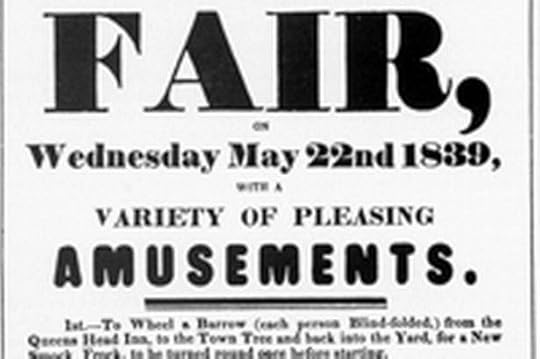
This morning dawned grey and dull – not great weather for Pinner Fair which takes place today. Traditionally held on the Wednesday after the Spring Bank Holiday, Pinner Fair dates back to 1336 and the reign of King Edward III. I remember it well as a child (in the 1970's, I hasten to add, not the 1300's.) This charter allowed the Mayor of Harrow to hold a weekly market and a larger fair up to five times a year. This has survived down the centuries as the annual fair in May.
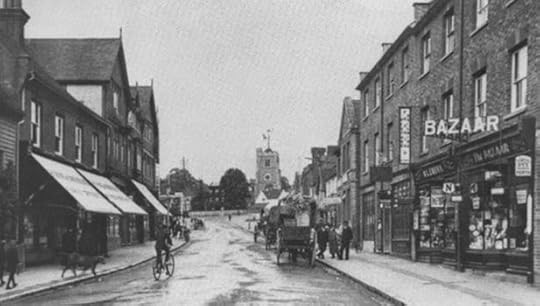 Pinner High Street, 1908 (without the fair present!)As a child growing up near Pinner, I used to walk into the village with my father to watch the rides being set up. The walk still is very pleasant, especially at this time of year with the trees in blossom, but it is essentially a stroll through suburbia, albeit with neat front gardens and well-to-do houses. Quite different from what met the visitor in the 1830's.
Pinner High Street, 1908 (without the fair present!)As a child growing up near Pinner, I used to walk into the village with my father to watch the rides being set up. The walk still is very pleasant, especially at this time of year with the trees in blossom, but it is essentially a stroll through suburbia, albeit with neat front gardens and well-to-do houses. Quite different from what met the visitor in the 1830's.'We used to go across the fields about four miles to Pinner.'Revd. Henry Torre
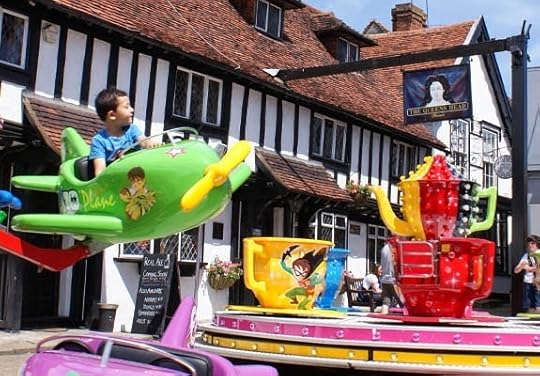 The Queen's Head in the backgroundMy father and I would walk along Bridge Street and the High Street to watch the lorries being unloaded and the bustle of rides being set up. In previous decades this was regimented by the police and a sergeant would blow his whistle at 6pm, to signal the start of the 'rush-in' to claim the best pitches. The fair people, who were waiting in side streets, would rush to their favourite spot and lay claim to it by sticking a pole in the gutter.
The Queen's Head in the backgroundMy father and I would walk along Bridge Street and the High Street to watch the lorries being unloaded and the bustle of rides being set up. In previous decades this was regimented by the police and a sergeant would blow his whistle at 6pm, to signal the start of the 'rush-in' to claim the best pitches. The fair people, who were waiting in side streets, would rush to their favourite spot and lay claim to it by sticking a pole in the gutter.
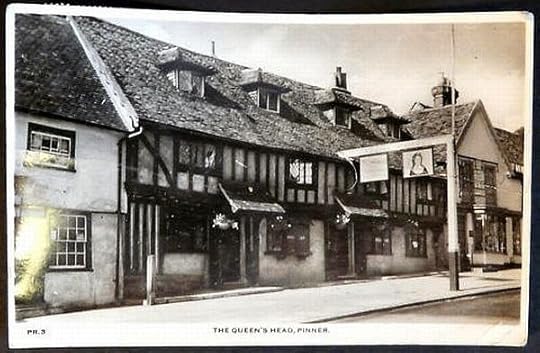 The Queen's Head, PinnerAs a child I had two favourite rides; the ponies that ambled up and down the lane outside the Police Station, and the traditional carousel roundabout at the top of the hill beside the parish church. The last time I visited the fair was with my own children, several years ago and although the carousel roundabout survives, the ponies giving rides are no more. Although the relatively innocent stalls of hooking a duck on a stick still exist today, more and more of the rides as noisy mechanical rides designed to thrill and frighten. A lot has changed since those earlier fairs.
The Queen's Head, PinnerAs a child I had two favourite rides; the ponies that ambled up and down the lane outside the Police Station, and the traditional carousel roundabout at the top of the hill beside the parish church. The last time I visited the fair was with my own children, several years ago and although the carousel roundabout survives, the ponies giving rides are no more. Although the relatively innocent stalls of hooking a duck on a stick still exist today, more and more of the rides as noisy mechanical rides designed to thrill and frighten. A lot has changed since those earlier fairs.
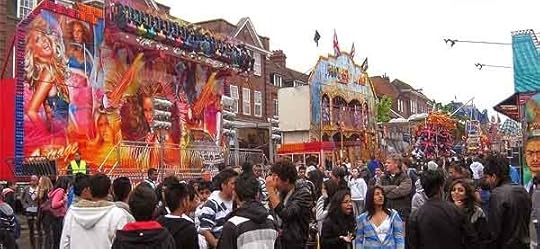 Pinner Fair in the modern day
Pinner Fair in the modern day'The chief attractions were roundabouts, swinging-boats, single-stick and boxing matches; among the labourers, jumping in sacks, climbing a greased pole for a leg of mutton or a hat on the top, and last but not least in importance a dance at a public house.'Revd. Henry Torre. Recollections of School Days at Harrow (1890)
Some of the public houses in Pinner, such as the Queen's Head, and The Victory, date back centuries. Nowadays the publicans are content to make money from visitors to the fair popping in for refreshments, but in past centuries they were more enterprising. Dancing booths were popular and the local publicans often took advantage of the crowds to organize a dance in a side room.
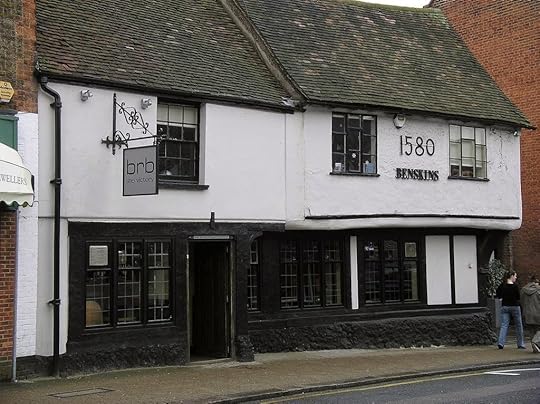 In my day this pub was called The Victory.'The dancing was in a small room, and the atmosphere, impregnated with the smell of beer and tobacco, and the noise of dancing in chaw-boots, to a merry fiddle were something indescribable. Dancing continued till about midnight, when we walked back to Harrow.'
In my day this pub was called The Victory.'The dancing was in a small room, and the atmosphere, impregnated with the smell of beer and tobacco, and the noise of dancing in chaw-boots, to a merry fiddle were something indescribable. Dancing continued till about midnight, when we walked back to Harrow.'
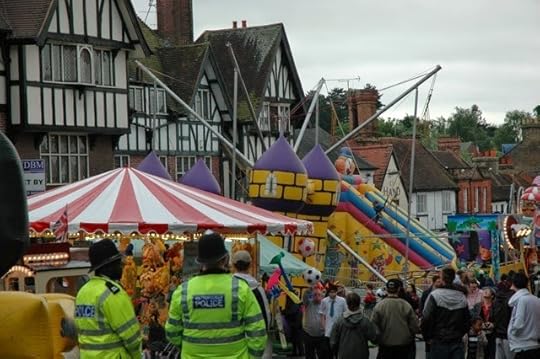 A drizzly day at Pinner fair
A drizzly day at Pinner fairNowadays, there is no dancing, but plenty of eating and drinking. For the one day of the fair the main roads of the High Street and Bridge Street are closed to traffic to make way for the attractions. It must be a sign of my age but the fair lacks the magic it held for me as a child. It just seems noisy, dirty and expensive. So what about you? Do you like fairs?
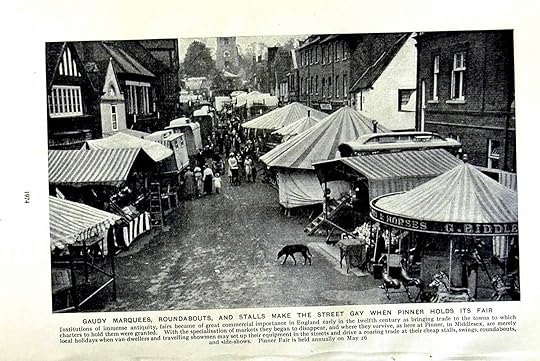
Published on May 28, 2014 01:26
'Familiar Felines.'
Following on from last weeks Halloween posting, today's blog post looks at the unwanted image of cats as the witches familiar - from the Norse Goddess Freya to lonely women in the middle ages.
The full Following on from last weeks Halloween posting, today's blog post looks at the unwanted image of cats as the witches familiar - from the Norse Goddess Freya to lonely women in the middle ages.
The full post can found at:
http://graceelliot-author.blogspot.com
...more
The full Following on from last weeks Halloween posting, today's blog post looks at the unwanted image of cats as the witches familiar - from the Norse Goddess Freya to lonely women in the middle ages.
The full post can found at:
http://graceelliot-author.blogspot.com
...more
- Grace Elliot's profile
- 156 followers



